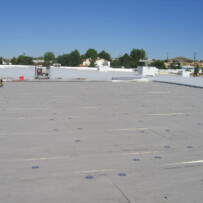
If you want an energy-efficient roof, the first place to start is insulation. Proper insulation is one of the most important contributors to a building’s energy efficiency. Having a high R-value for your roof, the common measurement of thermal resistance, can also aid in achieving LEED® v4 and RoofPoint(TM) certifications.
What’s Recommended
The National Roofing Contractors Association (NRCA) recommends using two layers of insulation. This can be comprised of two layers of insulation boards or a single layer of insulation and a cover board. Always follow your local building codes when choosing the materials for a roof.
Comparison of Three Types of Foam Insulation
| Type | Advantages | Caveats |
| Polyisocyanurate (Polyiso) |
| Must be used with a cover board if using asphalt |
| Extruded Polystyrene (XPS) |
|
|
| Expanded Polystyrene (EPS or Bead Board) |
|
|
Cover Boards
Cover boards go on top of the insulation layer, protecting it from hot asphalt and adhesives. Depending on the cover board type, they can also protect the roof from fire, moisture, foot traffic, loads and provide thermal resistance. In fact, the NRCA recommends cover boards for all roofing systems. GenFlex has a wide selection of different types of cover boards to meet your needs. Here are three of them:
- Structodek(R) is a great choice if you are looking for lightweight, high-density, wood fiber cover board.
- HD ISO is well worth considering since it is lightweight, strong (aids in protecting against hail damage, foot traffic and other loads), energy efficient, easy to cut, moisture and mold resistant, wind resistant, fire resistant and available in either flat or tapered boards.
- Coated Glass Facer Polyiso provides outstanding fire, wind and thermal performance for single-ply and modified bitumen commercial roofing applications.
If you are interested in learning more about insulation and cover boards, GenFlex University has a great online-education course about them. For design assistance or to request a quote, please contact estimatingservicesdept@genflex.com.
